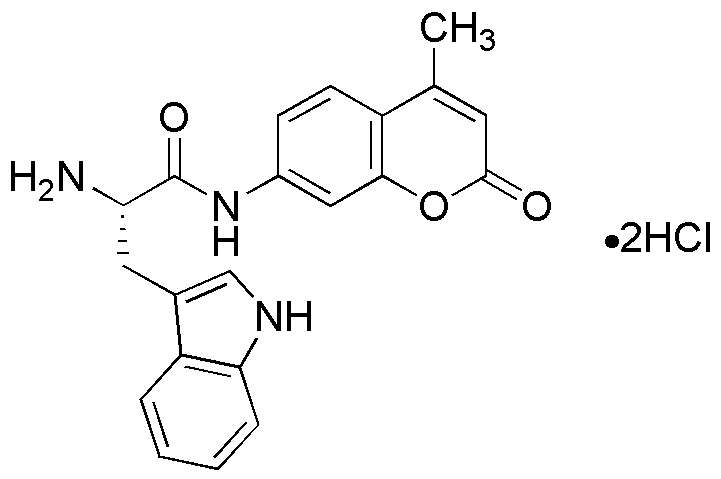L-Tryptophan-7-amido-4-methylcoumarin dihydrochloride is widely utilized in research focused on:
- Fluorescent Probes: This compound serves as a fluorescent probe in biochemical assays, allowing researchers to track biological processes in real-time.
- Drug Development: It is used in the development of pharmaceuticals targeting serotonin pathways, which can aid in treating mood disorders and other neurological conditions.
- Biochemical Research: The compound is valuable in studying protein interactions and enzyme activities, providing insights into cellular mechanisms.
- Diagnostics: It plays a role in diagnostic assays for detecting specific biomolecules, enhancing the sensitivity and specificity of tests.
- Material Science: This chemical is explored in the development of advanced materials, such as biosensors, due to its unique optical properties.
General Information
Properties
Safety and Regulations
Applications
L-Tryptophan-7-amido-4-methylcoumarin dihydrochloride is widely utilized in research focused on:
- Fluorescent Probes: This compound serves as a fluorescent probe in biochemical assays, allowing researchers to track biological processes in real-time.
- Drug Development: It is used in the development of pharmaceuticals targeting serotonin pathways, which can aid in treating mood disorders and other neurological conditions.
- Biochemical Research: The compound is valuable in studying protein interactions and enzyme activities, providing insights into cellular mechanisms.
- Diagnostics: It plays a role in diagnostic assays for detecting specific biomolecules, enhancing the sensitivity and specificity of tests.
- Material Science: This chemical is explored in the development of advanced materials, such as biosensors, due to its unique optical properties.
Documents
Safety Data Sheets (SDS)
The SDS provides comprehensive safety information on handling, storage, and disposal of the product.
Product Specification (PS)
The PS provides a comprehensive breakdown of the product’s properties, including chemical composition, physical state, purity, and storage requirements. It also details acceptable quality ranges and the product's intended applications.
Certificates of Analysis (COA)
Search for Certificates of Analysis (COA) by entering the products Lot Number. Lot and Batch Numbers can be found on a product’s label following the words ‘Lot’ or ‘Batch’.
*Catalog Number
*Lot Number
Certificates Of Origin (COO)
This COO confirms the country where the product was manufactured, and also details the materials and components used in it and whether it is derived from natural, synthetic, or other specific sources. This certificate may be required for customs, trade, and regulatory compliance.
*Catalog Number
*Lot Number
Safety Data Sheets (SDS)
The SDS provides comprehensive safety information on handling, storage, and disposal of the product.
DownloadProduct Specification (PS)
The PS provides a comprehensive breakdown of the product’s properties, including chemical composition, physical state, purity, and storage requirements. It also details acceptable quality ranges and the product's intended applications.
DownloadCertificates of Analysis (COA)
Search for Certificates of Analysis (COA) by entering the products Lot Number. Lot and Batch Numbers can be found on a product’s label following the words ‘Lot’ or ‘Batch’.
*Catalog Number
*Lot Number
Certificates Of Origin (COO)
This COO confirms the country where the product was manufactured, and also details the materials and components used in it and whether it is derived from natural, synthetic, or other specific sources. This certificate may be required for customs, trade, and regulatory compliance.


